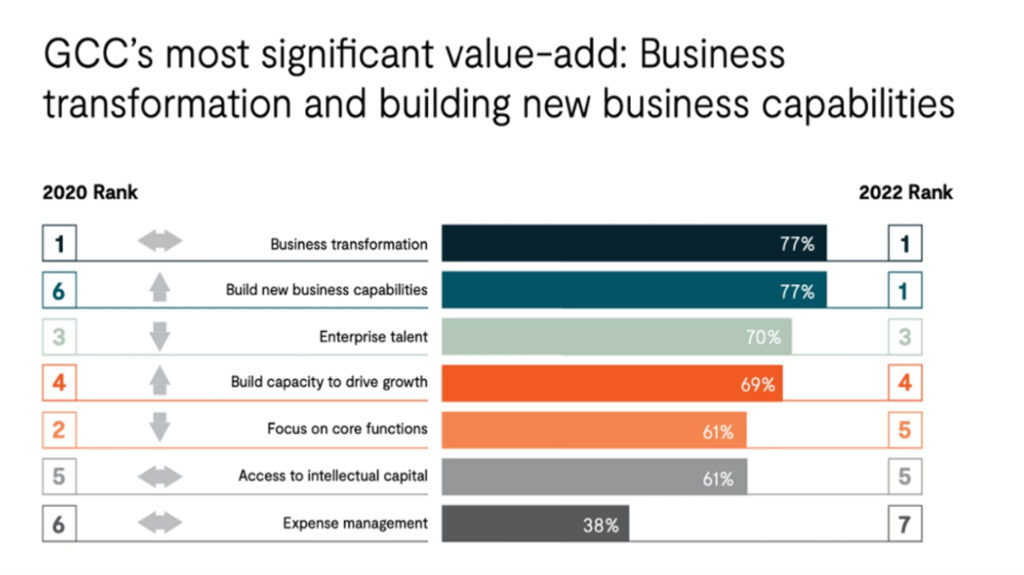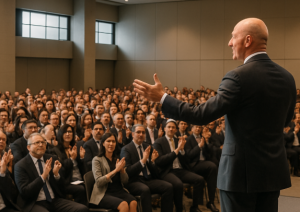What Future-Proofing Your GCC Means in 2024
Published on
Global Capability Centers (GCCs) have come of age. They have evolved from being a source of cost arbitrage to becoming centers of excellence for innovation, digital transformation, and top talent.
In the post-pandemic world, GCCs are expected to push the envelope of technology and data analytics to build the trust with the headquarters and become even more integral to their relevancy and future-proofing agenda.
Thinking ahead of the HQ
As enterprises navigate unprecedented business challenges, digital acceleration and changing customer behavior, they are looking to their GCCs to serve as a robust support system with differentiated talent. While most GCCs do just that, forward thinking GCCs must see beyond the current scope and help their parents grasp new opportunities, form strategic plans to adapt to new business trends, and build new capabilities.

[According to an ANSR survey, ‘business transformation’ remains the most significant value-add by GCCs. ‘Building new capabilities’ has moved 5 spots from 2020 to become the second biggest value add. *Arrows represent increase/decrease in percentage of respondents]
Analytics and AI have been taking a strong foothold in GCCs, powering evidence-backed, data-driven decisions for the HQ. The India GCC of a global bank is using financial data with proprietary AI model to provide higher visibility on cash flow. The platform is used today to monitor cash-flow parameters such as account receivables, delayed payments, credit risk and bad debt and help make timely predictions on variation of cash and bad debt. While significantly improving employee and customer experience, this proactive initiative has elevated the GCC’s credibility to drive business outcomes, while continuing to own critical elements of the HQ’s core tech agenda.
The path to future-proofing GCCs starts by moving beyond their BAU responsibility and into data-driven decision-making with AI-powered predictive analytics. Such GCCs will identify the right signals from the noise and help businesses stay ahead of disruptions, thus driving competitive advantage for the enterprise.
Elevating workforce skills
Technology changes fast and becomes obsolete faster. Therefore, GCCs should invest in talent that can adapt to such changes and upskill and reskill them continuously. Studies have shown that more than 60% of a company’s future roles can be filled by current employees, assuming adequate programs are in place. Reskilling is also cheaper than recruiting new talent for filling new business-critical roles.
As modern GCCs look to be at a peer level with their HQ, there’s an urgent need to develop future leaders who have a seat at the table. Give people full ownership of projects, let them make decisions, and give them the opportunity to ask critical questions and contribute strategic ideas that shape enterprise-level KPIs.
A mature GCC of a leading US retailer has ten VPs based in the India center and working in close alignment with the headquarters. These leaders have end-to-end ownership of their functions and the ability to influence the executive team. This culture of nurturing leaders at the GCC and giving them a seat at the table is what helped this GCC rise to the stature of the ‘second headquarters.’
Leveraging ecosystems to fuel innovation-based growth
Innovation is no longer an option but a necessity for companies to survive and succeed in the growing competitive environment. Forward-thinking leaders know that the raison d’etre of a GCC has now changed to driving product innovation at speed.
For building ‘disruptive efficiencies,’ GCCs should follow a combination of closed and open innovation, where they foster a culture of intrapreneurship as well as engage with the partner ecosystem. The success lies in establishing a symbiotic relationship between the ecosystem, the GCC and the HQ.
Ecosystems help deliver products, services, and experiences that would be difficult, if not impossible, for the GCCs to achieve on their own. However, only a handful of GCCs leverage the power of ecosystems. GCCs looking to future-proof themselves should leverage this ecosystem to establish a self-sustainable and frugal innovation construct, which increases their maturity and moves them up the value chain.
To drive scale and innovation, the GCC of a leading Latin American retailer operates in a hybrid model by hiring top talent and partnering with best-in-class technology consultants. This has helped the GCC build its technology capability and maturity across their digital platform and successfully raise the technology bar within the Group. The hybrid model also allowed the GCC to hire the right kind of talent as they became attractive due to the nature of work being carried out in India.
They are exploring the limitless possibilities of innovation by partnering with start-ups through several accelerator programs.
Using culture as the ‘secret sauce’
Peter Drucker famously said – “Culture eats strategy for breakfast.” Unexpected events like a pandemic can cripple a well-thought-out strategy but a company that builds and maintains a customer and employee-centric culture will stay strong in tough times. During the first wave of the pandemic, when India was in a better position than the US with fewer infections, the India GCC of a leading US retailer did everything in their capacity to support the US team. Later, India was grappled by the debilitating second wave and the US team extended their helping hand saying, “you took care of us in the first wave, now we will take care of you.”
For Global Capability Centres, such levels of camaraderie and collaboration with the headquarters team is indispensable for bringing people together and nurturing the company culture. When GCCs truly imbibe the kind of culture the parent organizations want them to embody, they create a virtuous cycle, attracting the right talent that will thrive in their culture, unlock their future-proofing agenda, and “supercharge” performance.




